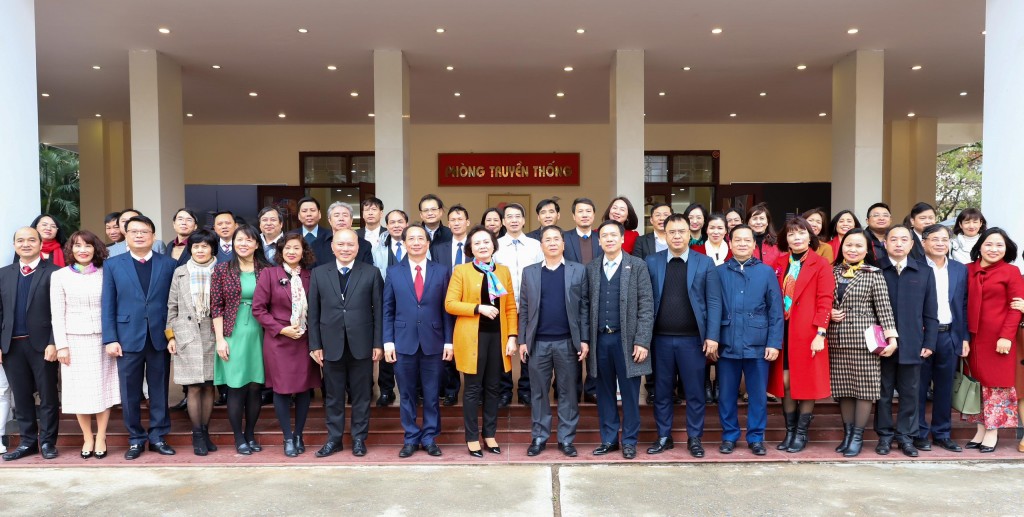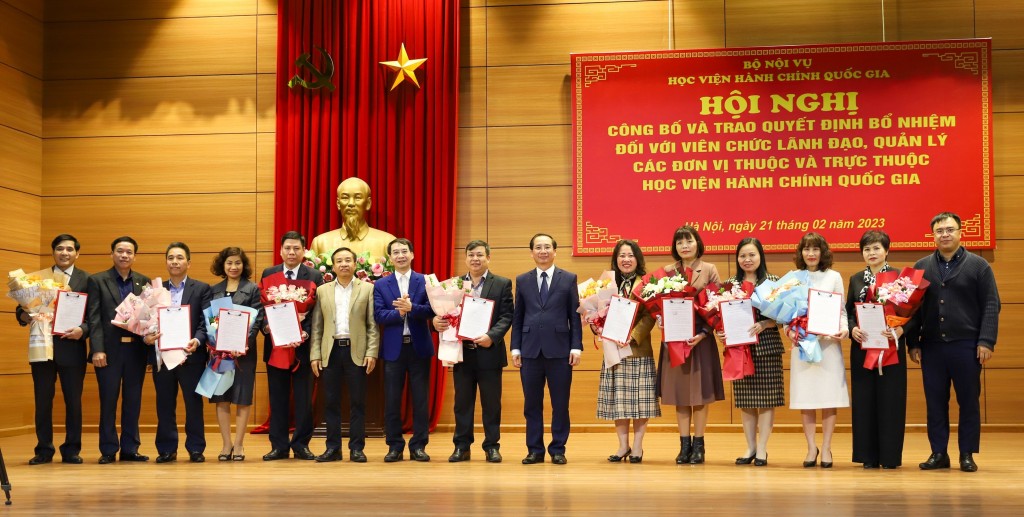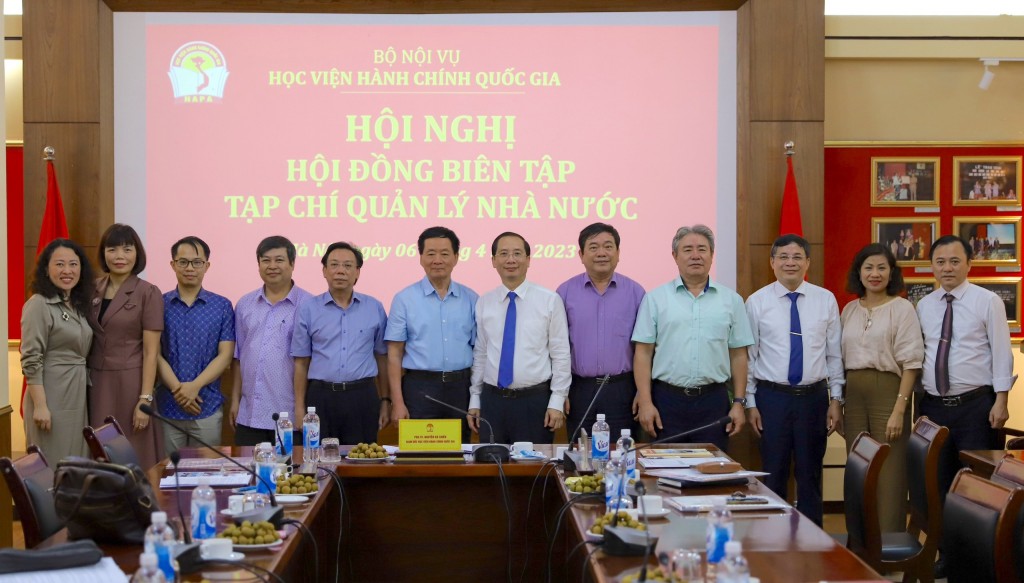On the occasion of the 64th founding anniversary of the National Academy of Public Administration (May 29, 1959 – May 29, 2023), NAPA would like to present the article “National Academy of Public Administration – From Tradition to A New Journey” of Assoc. Prof. Dr. Nguyen Ba Chien, NAPA President.
Looking back at the 64-year history of the National Academy of Public Administration
On May 29, 1959, the School of Public Administration under the Ministry of Home Affairs, the predecessor of NAPA, was established under Decree No. 214-NV signed by the Vice Prime Minister cum Minister of Home Affairs Phan Ke Toai. Its mission was to provide training for public officials at the district level, thereby contributing to the construction of the revolutionary government and achieving the goals of resistance war and national construction.
In response to the requirements of the revolutionary cause and the promotion of socialist construction in the North of Viet Nam, as well as the preparation of cadres for the national resistance war against the United States to save the country and liberate the South while also enhancing the legal status in line with the position of the School, on September 29, 1961, the Government issued Decree No. 130-CP, renaming the School to Central School of Public Administration. At this time, the mission of the School was not only to train public officials for the administrative system but also to train cadre forces to support the South, participate in combat, and, when conditions allowed, take over, organize and manage the liberated areas.
After the reunification of the country, in response to the demand for training and development of cadres and public officials for the southern provinces as well as the need to innovate the training program for cadres and public officials in the new era, and to reduce the overlap in training nationwide, the Council of Ministers (now the Government) issued Decision No. 91/HDBT on September 26, 1981, which defined the tasks and organizational structure of the Central School of Public Administration.

Phu Luu Village Communal House in Phu Luu Hamlet, Tan Hong Commune, Tu Son District, Bac Ninh Province – The location of the first training course of the School of Public Administration, inaugurated on October 16, 1959, and concluded on January 16, 1960.
In response to the requirements of the Doi moi process, transitioning from a centrally planned and subsidized economy to a market economy under the state management and gradually integrating into the international community while increasing the legal status of the Central School of Public Administration, on November 1, 1990, the Chairman of the Council of Ministers issued Decision No. 381/CT to rename the Central School of Public Administration to the National School of Public Administration.
In implementing the process of administrative reform, a top priority is the training and development of a professional, dedicated public service workforce to serve the people. Faced with the demands of reform, market mechanism and increasing government assignments, it was necessary to elevate the legal position of the School as a governmental agency. The National School of Public Administration was renamed to the National Academy of Public Administration according to Decree No. 253-HDBT dated July 6, 1992, of the Council of Ministers. The Decree clearly defined the functions, tasks, powers and organizational structure of the National Academy of Public Administration (NAPA), which operated under the direct direction of the government.
Due to the requirement of streamlining the state apparatus, on September 19, 2002, the Prime Minister issued Decision No. 123/2002/QD-TTg, transferring the National Academy of Public Administration under the state management of the Ministry of Home Affairs. On November 13, 2003, the Prime Minister signed Decision No. 234/2003/QD-TTg, which defined the functions, tasks, powers and organizational structure of the National Academy of Public Administration.
From May 2007 to December 2013, the National Academy of Public Administration and the Ho Chi Minh National Academy of Politics were merged to form the Ho Chi Minh National Academy of Politics and Public Administration, according to Decision No. 60-QD/TW dated May 7, 2007 of the Politburo. The National Academy of Public Administration was renamed the Academy of Public Administration.
On December 10, 2013, the Government issued Resolution No. 121/NQ-CP, which stipulated that “Transfer the Academy of Public Administration from the Ho Chi Minh National Academy of Politics and Public Administration to the Ministry of Home Affairs, according to Conclusion No. 64-KL/TW dated May 28, 2013 of the 7th Central Committee of the Communist Party of Viet Nam (XI term) and Document No. 176-CV/TW dated October 23, 2013 of the Secretariat, with the new name being the National Academy of Public Administration.
In accordance with Decision No. 27/2022/QD-TTg dated December 19, 2022 of the Prime Minister, Hanoi University of Home Affairs merged into the National Academy of Public Administration. Accordingly, the National Academy of Public Administration is identified as a special-class non-business unit, a national center performing the functions of training and upgrading competencies, knowledge and skills in administration, leadership and management for cadres, civil servants, and public employees; human resource training; research on administrative sciences; giving advice and consultancy to the Ministry of Home Affairs on public administration and state management.
Over half a century of construction and development, the National Academy of Public Administration has taken on different names and been assigned corresponding tasks in accordance with the requirements of the revolutionary practice in each period of its history. Initially, the Academy was just a training institution for district-level public officials. Today, the National Academy of Public Administration has truly become a national center for training public officials, human resources, research, and policy advice, in the field of administration and state management. It is headquartered in Hanoi and has branch campuses in strategically important areas of the country, serving as the pioneer in training in state organization, public management, and public policy. Furthermore, it is also a prestigious scientific center that gradually integrates into the regional and global context.
Over the past 64 years, the Academy has provided training for hundreds of thousands of mid-career and senior leaders and managers, as well as public officials for the state administrative system and the political system. Graduates from the Academy, including public officials and participants, have matured and made significant contributions to the country’s management activities. Many of them have held important positions in strategic leadership agencies of the Party and the State, as well as key managerial positions at the central and local levels.
In the field of scientific research and consulting, the Academy is recognized as one of the leading institutions providing scientific arguments for the Party, State, Government, and the Ministry of Home Affairs in developing perspectives, undertakings, strategies, mechanisms and management policies for public servants, public service activities as well as advising state administrative agencies and enterprises on public administration and state management. Since the 1990s, during the initial steps of administrative reform, the scientific contributions of researchers from the Academy have left their mark with valuable research works of great significance and visionary perspectives of the time.
The Academy has established and developed a wide-ranging international cooperation network spanning from Asia, Europe to the Americas, with leading universities and research institutes in public administration, public management, and public policy. The Academy is a member of many prestigious forums in the region and worldwide. With the goal of sharing knowledge, connecting, and promoting the image of Viet Nam to countries within the region and internationally, the Academy has provided training for many senior public officials from countries in the region, affirming its prestige and Viet Nam’s reputation in training public officials.
New requirements for the National Academy of Public Administration
The industrial revolution 4.0, along with its opportunities, has presented numerous challenges for every country. Modern national governance requires an innovative and creative public service that not only identifies opportunities for development but also recognizes challenges and difficulties, capable of proposing adaptive solutions in ever-changing management.
To build a creative, transparent, accountable, efficient, and effective state administrative system that serves the people and businesses, the most important pillar is the development of a competent and capable civil service workforce that meets the demands of the tasks set. In the current stage, entrepreneurship is a significant driving force for Viet Nam’s development. Therefore, the civil service workforce must possess an entrepreneurial spirit, foster a culture of entrepreneurship, support startups, initiatives, and innovative ideas, and create the necessary conditions for an entrepreneurial mindset. One of the vital forces in the nation’s fight today is the entrepreneurs, and we must build a civil service workforce that serves as the backbone and support for entrepreneurship in this new era. If entrepreneurship is one of the measures of success for a government focused on innovation, then developing a civil service workforce that supports entrepreneurship becomes a goal for the innovation of civil service training and development.
To build a creative, accountable, and service-oriented civil service workforce, business community and training institutions, including NAPA, must ensure that students and participants have the necessary skills to become capable public officials who can meet the development requirements of the country and compete internationally in the current context of globalization. To do so, the primary responsibility lies with education managers, training institutions, and in this case, NAPA.
Johann Wolfgang von Goethe, a prominent German figure in the 18th century, once said, “The greatest thing in this world is not so much where we stand as in what direction we are moving”. So, in the coming years, where will NAPA stand? How should we answer this question? It is a significant question that the Academy needs to contemplate thoroughly and comprehensively in order to successfully complete the tasks assigned by the Party, the Government, and the Ministry of Home Affairs.
The Party and the State of Viet Nam always attach great importance to the development of human resources, including public servants. Resolution of the 7th Plenum of the Central Committee of the Communist Party of Viet Nam (term XII) on focusing on building a contingent of comprehensive, qualified, and reputable public servants at all levels, especially at the strategic level, on a par with their duties, affirms that cadres are the decisive factor for the success or failure of the revolution; cadre work is the “key link” in the construction of the Party and the political system. Building a contingent of cadres, especially those at the strategic level, is the foremost important task of the Party, which must be carried out regularly, carefully, methodically, closely and effectively. Investing in building the cadre contingent is an investment for long-term and sustainable development. The work of building the cadre contingent has achieved positive results. However, in the face of new task requirements in the new situation, there is a need for renewal in the training of public sector human resources. NAPA must not be satisfied with what has been achieved but must strive with a spirit of innovation, advancement, breakthrough, daring to think and act, knowing how to do, and daring to take responsibility.
In today’s era, knowledge is being created at a faster and greater pace, but it also tends to become obsolete quickly. Therefore, NAPA must constantly update new knowledge and truly be a center for innovation and knowledge transfer, so that the contents of the training courses at the Academy become a repository, a refinement of the most comprehensive and in-depth knowledge suitable for the reality of Viet Nam, in the context of the country integrating with the region and the world.
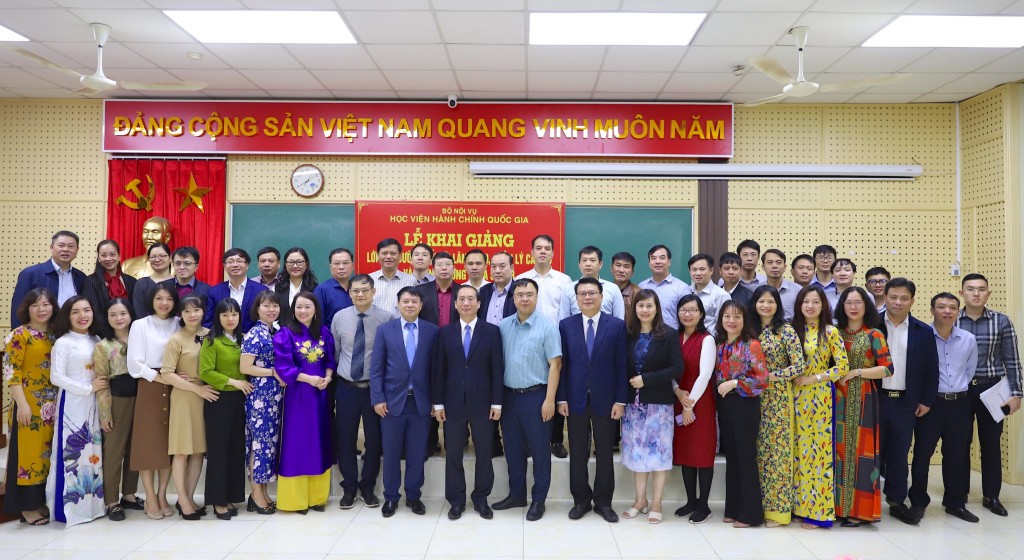
Opening ceremony of the training course on leadership and management at the ministerial department level – Cohort 5 in 2023.
National Academy of Public Administration on a new journey
The National Academy of Public Administration enters its 64th year of tradition with a new history. The merger of Hanoi University of Home Affairs into the National Academy of Public Administration not only enhances its political and legal status but also expands the scope of the Academy. The tradition forged by the Academy over 64 years, combined with the over 50 years of tradition from the Hanoi University of Home Affairs, is the foundation for creating new cultural values and generating new impetus for innovation and development. With enhanced resources, particularly human resources, the Academy is well-positioned to become not only a national center for officials and civil servants but also a high-quality higher education institution that meets the requirements of quality human resource training in the public sector and society at large.
In the next period, the National Academy of Public Administration should focus on implementing the following major directions:
First, focusing on innovation and creativity in performing its functions and tasks. The Academy should proactively research and propose comprehensive renovations to improve the efficiency of the Academy’s fields of operation. It is necessary to establish a vision and aspiration to become a training center for leaders and managers on a par with Southeast Asia and Asia – Pacific regions, as well as a prestigious higher education institution with sufficient capacity to undertake great responsibilities in the field of high-quality human resource training and professional development of public servants. This will affirm its irreplaceable position whenever training in public administration, public policy, human resource management, social management, and capability development for leaders and professional officials is mentioned.
Second, prioritizing the continuous improvement of the quality of its staff, particularly its faculty members. It is essential that NAPA trainers truly master expertise in both theoretical knowledge and practical application. In the coming period, the Academy should allocate necessary resources to develop its trainers and researchers, strengthen academic exchange activities, and promote international cooperation programs to enhance human resources training. The Academy should have investment plans to develop the capacity of its faculty, with a focus on attracting reputable international experts in public policy, public administration, public management and other related fields. Additionally, efforts should be made to build a team of qualified trainers and guest speakers who have both comprehensive training and extensive practical experience.
Third, accelerating digital transformation and establishing NAPA as a truly modern institution by reforming administrative procedures. The digital transformation process should aim to unlock resources, foster connections, and facilitate the sharing of knowledge and information, thereby enhancing the efficiency of management, administration, teaching, and learning. In addition to theoretical lectures, students will have hands-on experience with the real-world application of digital transformation in the Academy’s day-to-day operations.
Fourth, enhancing the quality of training and development for officials and civil servants, undergraduate, master’s, and doctoral programs, as well as professional development courses at the Academy. In the training process, the Academy needs to deeply adhere to the principle that learners are the central focus, and educational quality is of paramount importance. All innovative efforts should aim at improving the quality of training and development, ensuring that the training process at the Academy can enhance the public sector capabilities so that students have better knowledge and skills, as well as higher levels of motivation after the training process.
The Academy focuses on the innovation of training programs. The program content must be closely linked to practical needs and requirements, providing new knowledge in both undergraduate and postgraduate education, filling knowledge gaps for public servants, and equipping them with the necessary foundations for future work. The knowledge imparted must be fresh, non-dogmatic, dynamic, up-to-date, and free from redundancy. It is necessary to establish output standards and develop specific and detailed competency levels for each training program, with necessary quantification that allows for comparison, examination, and evaluation. Undergraduate and postgraduate training programs and other public sector capacity development programs should not only focus on knowledge but also develop skills, values orientation, and future aspirations for students and public officials. This entails integrating the enhancement of analytical, evaluative, and predictive skills with practical situational handling.
Continuing to innovate teaching and learning methods at the Academy. The knowledge economy and information society demand drastic changes in both the content of training and methods of teaching and learning. It involves how teachers and students interact, how knowledge is generated, and how it is accessed and mastered. Therefore, the methods of training and development for officials and civil servants also need to be renewed. Online and multimedia-based training methods should be researched, developed, and integrated into traditional training approaches. To do so, the Academy must have a strong physical infrastructure and facilities. In addition, the Academy should be more dynamic in international cooperation and partnerships, attracting investment from external sources to not only gain valuable experiences and knowledge but also secure resources for upgrading infrastructure and equipment.
Fifth, improving the quality of academic research, enhancing independence and creativity in research activities, and generating products of profound practical value. Research products must contribute to the creation of new knowledge to effectively serve the training of pioneering leaders and managers and strategic managers with global, open-minded vision, capable of shouldering the responsibilities of the country. Building the scientific capacity of the Academy is really worthy so that the Government, ministries, sectors, and localities can commission policy research from the Academy. Actively expanding research collaboration activities in the era of globalization and international integration to provide the Academy with additional resources for research; at the same time, creating research products of great application value and pervasiveness.
Sixth, improving the quality of the State Management Review, approaching international standards. Focusing on investing in human resources, infrastructure, and technology so that the State Management Review can well implement digital transformation. Constantly improving the quality of research, ensuring to maintain a scientific index of 0.75 for all three publications, striving to achieve a score of 1.0 in the next few years. Meeting the necessary conditions to be included in the ACI journals list, targeting to be listed in the ISI and Scopus databases.
Continuing the development of the digital library across the whole Academy, following a centralized model and fostering connectivity throughout the institution, enhancing the integration of intelligent digital library services based on the principle of “autonomous operation and administration”. In particular, focusing on compliance with international industry standards and technological standards to ensure sustainable development and seamless integration with other units at the industry, national and international levels while complying with legal regulations and timely application and updates of legal provisions regarding the use of digital libraries. In the immediate future, focusing on the planned targets outlined in the plan until 2025, with a vision to 2030, in the spirit of Decision No. 206/QD-TTg dated February 11, 2021 of the Prime Minister approving the Digital transformation program for the Library sector. The digital library of the Academy should be developed to integrate the management of research records, linking with reputable international scientific databases such as ISI, Scopus, Google Scholar, etc.
Seventh, strengthening and improving the effectiveness of international cooperation activities. International cooperation activities should be focused and substantial, attracting investment resources to develop the capacity of trainers and researchers. It is essential to create an environment for Academy trainers to learn, exchange experiences, and enhance their working skills in an international setting. This will also enable them to access modern and up-to-date scientific knowledge and effectively apply and adapt it in line with the directions, tradition and public service culture of Viet Nam.
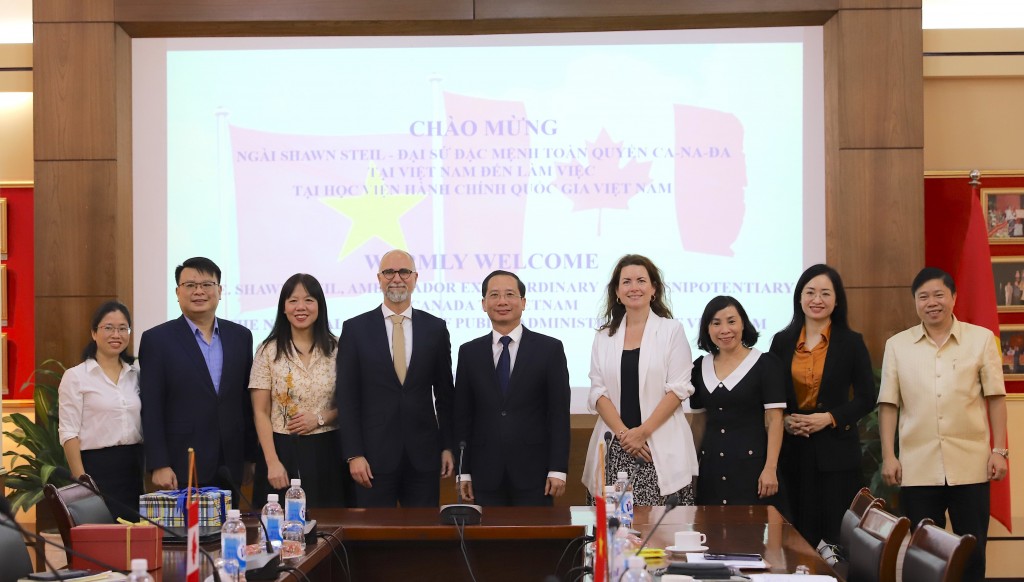
Assoc.Prof.Dr. Nguyen Ba Chien, NAPA President, working with H.E. Mr. Shawn Steil, Ambassador Extraordinary and Plenipotentiary of Canada to Viet Nam
Over the course of 64 years, the National Academy of Public Administration has embarked on a remarkable journey of construction and development and is now entering a new phase with new opportunities and challenges. In the context of a rapidly developing country aspiring for prosperity based on a knowledge foundation, failing to adapt or being slow to change would inevitably result in lagging behind.
To continue our legacy of excellence and retain our position as a pioneer, the Academy has set specific development goals as well as needs to be dynamic and discerning in choosing priority directions. At the same time, we should develop long-term development strategies, determine the roadmap and necessary steps to continue innovating and make tangible and significant contributions to the process of building a modern national governance system. NAPA should earn a reputation as the national center performing the functions of training and upgrading competencies, knowledge and skills in administration, leadership and management for cadres, civil servants, and public employees; human resource training; research on administrative sciences; giving advice and consultancy to the Ministry of Home Affairs on public administration and state management.
ASSOC.PROF.DR. NGUYEN BA CHIEN
NAPA President


